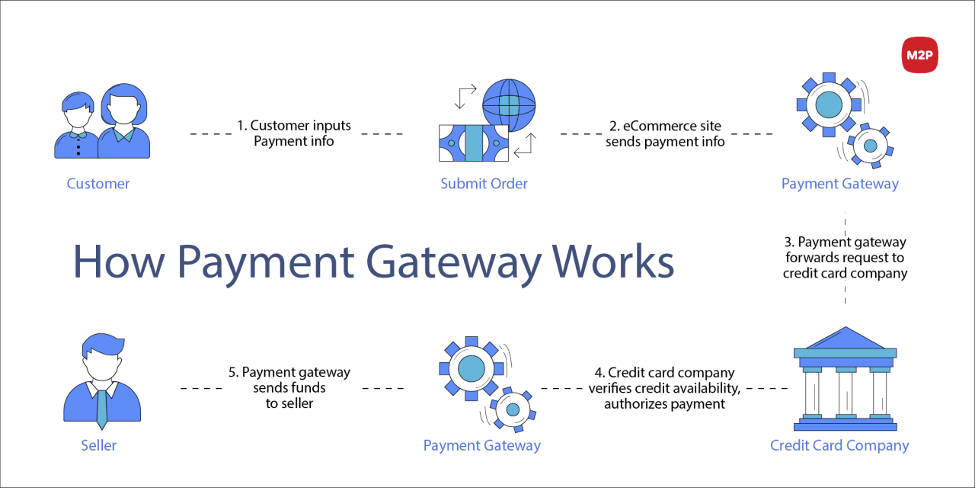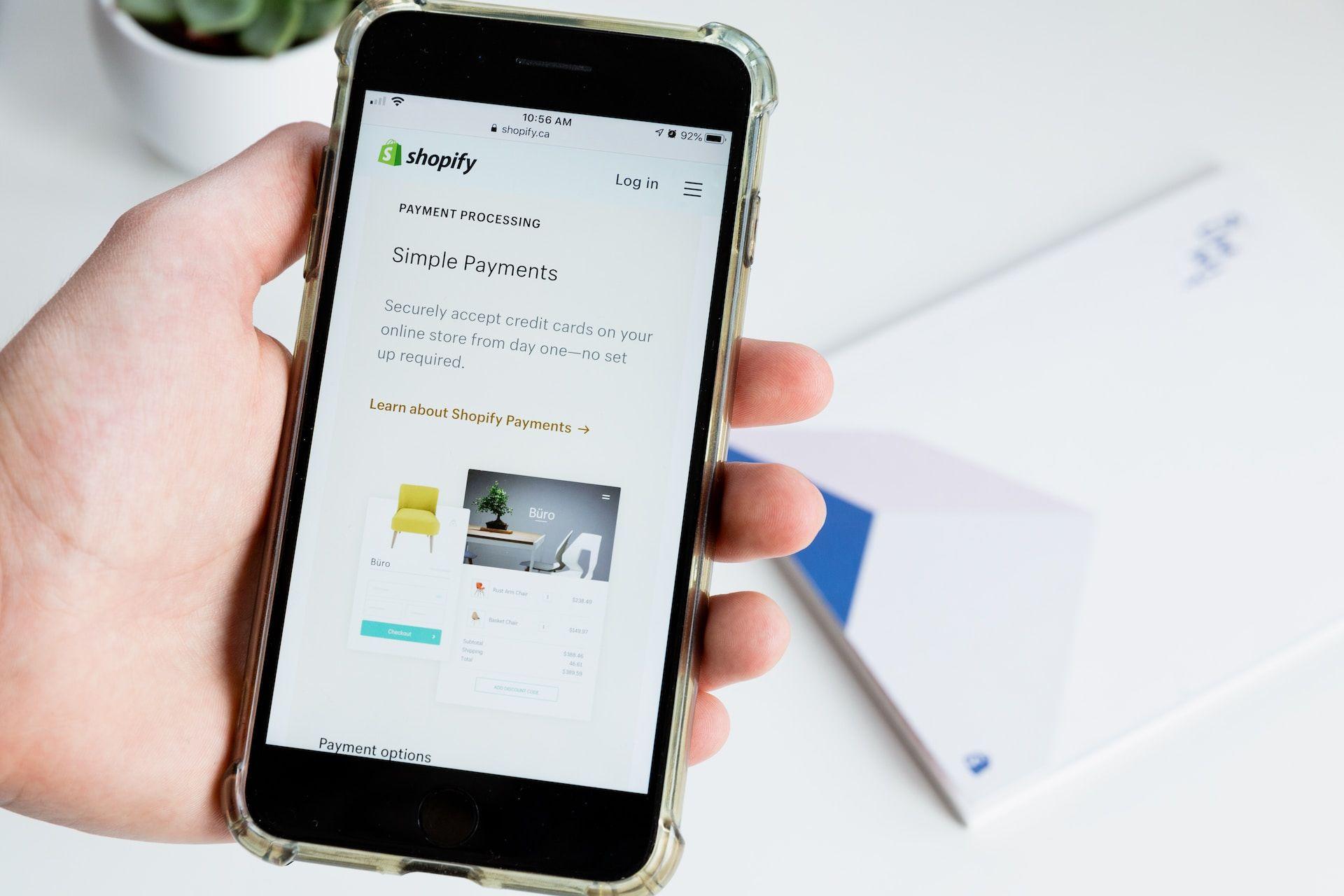This article will guide you through the benefits and importance of utilizing a payment gateway and provide step-by-step instructions on seamlessly integrating it with your existing business systems. It also highlights the advantages of building a custom payment solution.
So, get ready to enhance your payment processing, improve user experience, and boost customer satisfaction.
What is an Integrated Payment Solution
A payment gateway is a service that enables secure online transactions between a buyer and a seller by authorizing the transfer of funds from the buyer's account to the seller's. It acts as a bridge between the two, serving as a mediator in the transaction process.
How exactly does it work?
When a buyer initiates a payment transaction, the payment gateway first verifies the authenticity of the payment source, such as the buyer's credit card details or banking information. It then encrypts and securely sends this information to the seller's payment processor, which verifies the transaction request and checks for available funds.

If the funds are available, the payment processor sends an authorization message to the payment gateway, which confirms the transaction and notifies the buyer and seller of the successful payment completion. The seller can then provide the goods or services to the buyer, knowing that payment has been processed successfully.
Payment gateways use encryption and other security measures to protect sensitive payment data from unauthorized access and fraud. Some payment gateways offer additional features like fraud prevention and chargeback management.
Payment Gateway vs. Payment Processor
A payment gateway is a third-party service provider (such as PayPal or Amazon Pay) that enables secure online transactions between customers and merchants. Payment gateways typically charge a fee for their services based on transaction volume or a monthly subscription.
On the other hand, a payment processor is a service provider (such as Stripe or Braintree) that facilitates electronic transactions by communicating between the merchant acquiring bank and the customer issuing bank. Payment processors provide a more comprehensive solution that includes risk management, chargeback prevention, and transaction authorization. They also offer various services, such as recurring payments, mobile payments, and fraud detection.
While both solutions facilitate online payments, they play different roles in the payment process. Payment gateways are the intermediary between the merchant and the customer, while payment processors manage and authorize transactions with the banks.
Payment Integration Options
If a business wants to collect payments from customers smoothly and efficiently, it needs to choose an appropriate payment integration method. Let’s take a look at existing options.
Hosted Gateway: A hosted gateway is a payment integration option where the customer is redirected to a third-party website or payment gateway to complete the transaction. In this method, the customer enters their payment information on a secure page hosted by the payment gateway. The payment gateway then returns the transaction information back to the merchant's website. The hosted gateway is a popular option for small businesses because it requires minimal technical knowledge and is typically easy to integrate.
- Pros: Hosted gateways are easy to use, quick to set up, and typically have low maintenance costs. The payment gateway handles the security of the transaction, which reduces the merchant's liability and helps prevent fraud. Hosted gateways can also support multiple payment methods, including credit cards and online wallets.
- Cons: The hosted gateway means that the customer is taken away from the merchant's website, which can lead to a lack of continuity. This can cause confusion and may impact the customer's perception of the business. Merchants also typically have little control over the look and feel of the payment pages.
Direct Post Method: The direct post method is a payment integration option where the customer enters their payment information directly on the merchant's website. The information is then passed on to a secure payment gateway for processing.
- Pros: Direct post allows the merchant to maintain control of the payment process and the customers' experience throughout the transaction. The customizability of the payment pages allows for better incorporation with the merchant's branding and website design. The payment process can appear more seamless, providing a smoother user experience.
- Cons: Setting up a direct post-payment method requires more technical knowledge. Merchants need to ensure the security of the payment process, which can be more complex than in a hosted gateway. In addition, direct post typically requires more maintenance and may incur higher costs than other payment integration options.
Non-Hosted (Integrated) Method: Non-hosted (integrated) methods use an API, which allows the merchant to control the checkout experience and process payments on their website. This type of payment integration requires more technical knowledge, but it allows for greater customization and control over the payment process.
- Pros: The customizable API integration offers the highest level of control over the payment process. This integration provides a seamless payment experience for the customer. It also enables businesses to have complete control of the payment details without redirecting customers to third-parties, resulting in a smooth checkout process.
- Cons: Integrating an API needs an in-depth understanding of coding and software development. The complexity of the integration means that it may be more prone to errors. Additionally, businesses must establish and maintain secure payment processing, which can be time-consuming and expensive.
The choice of a payment integration option should depend on the business size, development skills, how customizable they want the checkout experience to be, and their financial situation. Hosted gateway and direct post methods are simpler, easier to maintain, with a lower risk of errors, and therefore are most suitable for small businesses. On the other hand, the non-hosted (Integrated) Method is better for businesses that require better customization options and management of the payment process. Regardless of which payment integration option businesses choose, they must ensure that the security of their payment processing system is up to the highest possible standards.
Processing Flow
The payment processing flow encompasses a series of intricate steps. The transaction starts with the customer, who triggers it by clicking on the "Purchase" button and providing the necessary transaction details, such as the card number, expiration date, and CVV. Once the transaction data is provided, it is encrypted to ensure its privacy and safety. The encrypted data is then passed to the merchant's web server via a highly-secured SSL connection. The merchant forwards the encrypted data to the payment gateway that stores the information in a protected storage mechanism after it is decrypted.
The payment gateway transmits the transaction data to the payment processor via another encrypted SSL channel. They interact with card networks like Visa, Mastercard, American Express, or Discover.The card network verifies the transaction data and forwards it to the issuer bank that produced the card held by the customer. At this stage, the issuer bank approves or rejects the transaction and sends a code indicating the transaction status back to the payment processor.
The payment processor then relays the transaction status to the payment gateway, which returns the status to the website. The customer then receives a notification of the transaction status through the payment system interface to confirm if the transaction went through successfully. If the transaction is accepted, the funds are transferred from the customer's account to the merchant's account. This process is executed within a few days, and the transaction becomes complete when the acquiring bank confirms receipt of the funds.
How can we help you achieve your digital goals?
Get in touchPayment Integration Process
The following steps will help you seamlessly integrate a payment system into your website:
- Choose a Payment Gateway Provider: There are numerous payment gateway providers in the market, such as PayPal, Stripe, or Square. Each provider has its own set of features, fees, and integrations, so you need to do some research to find the best fit for your business.
- Obtain API Credentials: Once you've selected a payment gateway provider, you'll need to register for an account and obtain API credentials. This will allow you to connect your website with the provider's infrastructure.
- Select and Implement the Payment Method: Depending on the payment gateway provider you choose, you'll have several options for payment methods, including credit card, debit card, PayPal, Apple Pay, or Google Pay. Decide which payment methods you want to offer on your website and implement them according to the provider's technical documentation.
- Configure the Payment Settings: Configure the payment settings in your website's backend, such as the payment amount, currency, and transaction fees. You may also need to set up an SSL certificate to ensure secure data transfer.
- Test and Launch: Before launching your website with the payment system, thoroughly test its functionality to minimize any technical glitches and ensure a smooth customer experience. Once everything functions correctly, launch your website confidently in your payment gateway integration.
Top Gateway Providers
Here is a list of popular payment gateway providers, along with their key features:
- PayPal: PayPal is one of the most popular payment gateway providers in the world, with over 267 million registered users. It offers fast and secure payment processing for both merchants and customers. PayPal gives customers multiple payment options, including credit/debit cards, bank transfers, and PayPal balance.
- Stripe: Stripe is a cloud-based payment processor that offers swift transactions and supports various payment methods like credit cards, Apple Pay and Google Pay. It is known for its easy-to-use interface and powerful developer tools.
- Square: Square is a payment processing provider suitable for small businesses. Its mobile card reader accepts credit/debit cards and contactless payments. Square also offers additional features such as POS integration and invoice generation.
- Amazon Pay: Amazon Pay is a payment processing platform provided by Amazon. It enables customers to use their Amazon accounts as a means of payment. Amazon Pay offers high-level security, quick checkout, and easy integration.
- Braintree: Braintree is a PayPal-owned payment gateway provider that offers a wide range of payment options, including PayPal, credit/debit cards, Apple Pay, and Google Pay. It is known for its user-friendly interface and easy-to-navigate checkout experience.
- Authorize.net: Authorize.net is a payment gateway provider that has been in the industry since 1996. It is a reliable and secure platform that supports a wide range of payment options. Authorize.net is popular for its robust fraud prevention system and automated recurring billing.
- Worldpay: Worldpay is a payment gateway provider with global reach, offering over 300 payment options and supporting over 146 currencies. It is known for its quick and easy checkout process, advanced security measures, and innovative payment solutions that cater to businesses of all sizes.
Custom Payment Solution for Marketplaces
Businesses can always opt to create their own payment solution. This is a complex and multi-step process that requires careful planning and execution, but it will provide many benefits. To start, a company must register as a payment gateway provider with one or multiple credit card companies through acquiring banks. This process will allow the payment processing company to securely exchange necessary information with credit card providers and generate payment transactions.
The next step is to contract with banks that will act as payment processors for your payment gateway. These banks will handle actual transaction processing, such as checking for sufficient funds, authentification of the cardholder, and payment transfers. The contracting of multiple banks can provide different transaction fees and rates for international transfers or currency exchange, which could be beneficial.
Afterward, the company must develop an API for their payment gateway. The API is essential and must comply with stringent security measures put in place by PCI DSS guidelines. The payment gateway solution must also implement secure and robust tokenization technology to encrypt sensitive data and prevent fraudulent activities. Tokenization improves security and lowers chargebacks by replacing sensitive information with dummy data.
Note: Integrating additional payment methods such as PayPal, Bitcoin, or mobile wallet options (e.g., Apple Pay) requires separate integrations with their respective APIs. The payment gateway provider must also develop a merchant administrative web application or an admin panel to allow their staff to control merchant operations. It is possible to use open-source payment gateway solutions such as OmniPay, PayU, or Active Merchant. However, these options have limited customization options and might not align with the company's exact needs.
Benefits of custom payment solution
A custom payment solution can offer a range of benefits that are essential to businesses and merchants alike.
- Cost-efficiency. One significant benefit is a reduction in transaction fees due to the avoidance of a gateway provider as a free-form factor. This allows businesses to save a significant amount of money that can be directed to other essential business operations.
- Customization. Another benefit of a custom payment solution is the level of customization that comes with it. Large enterprise businesses are often restricted by what vendors offer, which limits their capabilities. However, developing a custom payment solution allows businesses to implement any feature they desire, including recurring payments and multi-currency transactions. This increased flexibility makes it easier for merchants to serve their customers in the most convenient and efficient way possible.
- An additional source of revenue. One additional advantage of custom payment solutions is their potential as a product offering. With a custom payment solution in place, businesses and merchants can potentially offer it to other merchants and agents. This means that they can create an additional source of revenue while also providing a valuable service to others.
- Better security. Custom payment solutions offer added security and an increased level of transparency, which is essential in today's digital landscape. These customized solutions can provide businesses with a level of control over transactions, ensuring that all financial data is protected from fraud and security breaches.
Final Word
Payment gateways play a crucial role in facilitating secure online transactions for businesses and customers alike. Choosing the right provider will depend on your specific business needs, the types of payments you want to accept, and the security and convenience required.
If you want to build your own payment solution, Clover Dynamics is at your service. Using our extensive experience, we provide cutting-edge fintech solutions that accelerate business operations, reduce operating costs, increase income, and provide complete transparency of financial transactions for end users.
Contact us and we’ll find a way to help you!







